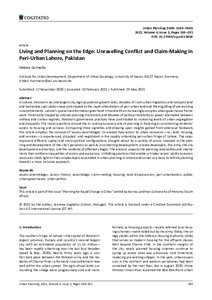| dcterms.abstract | In Lahore, Pakistan’s second largest city, high population growth rates, decades of rural-urban migration, and rampant land and real-estate speculation have contributed to the rapid urbanization of peri-urban land and the engulfing of pre-existing rural settlements. Lahore’s spatial transformation goes hand in hand with an increasingly complex urban governance framework. Historically shaped by colonial planning institutions and decades of political instability as power alternated between military and civilian regimes, Pakistan’s governance practices have contributed to increasing levels of urban segregation and inequality. This raises questions around the in- and exclusionary role of planning in fostering or constraining residents’ access to housing and services. Comparing three vignettes and drawing upon insights gained from extensive fieldwork, this article employs the concept of ‘access-assemblages’ to analyze how access to urban resources—i.e., land, housing, and services—is experienced, disputed, and negotiated in the rapidly urbanizing peri-urban fringe of Lahore. The cases represent different spatial and socio-political configurations brought about by a variety of actors involved in the planning and development of the city’s periphery as well as in contesting development: private developers, the army, the city development authorities, and the residents of affected villages. The analysis unpacks the planning rationalities and mechanisms that reinforce inequalities of access and exclusions. Unfolding practices that enable or hinder actors’ ability to access resources sheds light on the complex layers assembled in urban planning in Lahore and serves as a basis to rethink planning towards a more inclusive approach. | eng |


